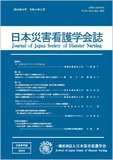Japanese
English
- 有料閲覧
- Abstract 文献概要
- 参考文献 Reference
要約
【目的】行政の災害リスクの対応の実態および災害リスクコミュニケーション要素の実施の実態を明らかにし、行政と地域住民との効果的な災害リスクコミュニケーション構築への示唆を得る。
【方法】令和3年12月から翌1月に、全国の全ての都道府県と市の災害対策担当課に、5段階の評定尺度による質問紙を送付し、回答を求めた。
【結果】全47県中29県(回収率61.7%)、全792市中460市(回収率58.1%)から回答があった。
【結論】地方自治体の「災害リスクの認識」、「災害リスクの把握」、「災害リスクの軽減対策」の各対応は、この順番で実施されており、実施程度は今後予測される災害の数に影響されていた。また、市より県が、管轄地域が広いことから、種々多様な災害に対応すべく、災害リスクの対応がされていた。災害リスクコミュニケーションは、「安全伝達」が比較的良く実施されており、次いで「共考機会」であるが、「責務共有」と「信頼構築」は、まだ不十分であった。また、被災経験があると各災害リスクコミュニケーション要素は比較的実施できていた。一方、「責務共有」は被災件数が少なかったり、予想件数が少ない市は、十分に実施できていないことがわかった。しかし、日本の災害状況を考慮すると、災害被災件数が少なくても、リスクを認識し、リスク把握に努める必要があり、災害リスクコミュニケーションの責務共有と信頼構築のための施策の検討と実施が必要である。
[Purpose] The purpose of this study was to identify how local governments are handling disaster risks, and to determine the extent to which each disaster risk communication element has been implemented, and to obtain suggestions for building effective disaster risk communication between government and local residents.
[Methods] From December 2021 to January 2022, questionnaires based on a five-level rating scale were sent to disaster countermeasures departments in all prefectures and cities across Japan, requesting that they respond.
[Results] Responses were received from 29 out of 47 prefectures (61.7%) and 460 out of 792 cities (58.1%).
[Conclusion] Actions by local governments in relation to “disaster risk awareness,” “disaster risk understanding,” and “disaster risk mitigation measures” were undertaken in this order, and were impacted by the number of disasters predicted to occur in the future. Since prefectures have larger jurisdictional areas than cities, the disaster risks they must address cover a wider variety of disasters. Regarding disaster risk communication, “safety communication” was shown to be relatively well implemented, followed by “counseling opportunities,” while “responsibility sharing” and“ trust building” remained insufficient. In addition, it was determined that each disaster risk communication element could be relatively well implemented once a disaster was experienced. Meanwhile, responses indicated that cities with a small number of disasters or with few expected disasters have not fully implemented “responsibility sharing.” However, considering the disaster situation in Japan, even if the number of disaster victims is small, it is necessary to recognize and understand the risks, and it is necessary to consider and implement measures to share the responsibility of disaster risk communication and build trust.
Copyright © 2023, Japan Society of Disaster Nursing All rights reserved.


